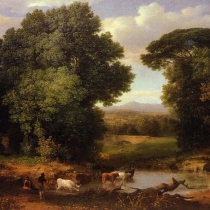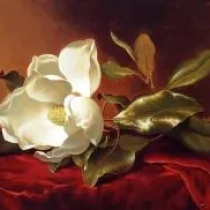 1825 - 1894
hudson river school
1825 - 1894
hudson river school
Description George Inness
George Inness, born on May 1, 1825, in Newburgh, New York, stands as a luminary in American landscape painting, his art navigating the intersections of nature, spirituality, and philosophy. Inness's journey unfolded against the backdrop of a nation in flux, grappling with the aftermath of the Civil War and the advent of industrialization.
Inness's early artistic endeavors were influenced by the Hudson River School, but a transformative trip to Europe exposed him to the Barbizon School and the profound spiritual depth of the Old Masters. This encounter ignited a paradigm shift in his approach, leading him to blend the luminosity of American landscapes with a nuanced, tonalist style reminiscent of European masters.
The core of Inness's art lay in his belief that nature was a conduit to the divine. His works, including "The Lackawanna Valley" and "The Storm," transcend mere representation, capturing the spiritual essence of the landscapes. Inness's use of light, atmosphere, and symbolic elements created an immersive experience, inviting viewers to reflect on the metaphysical aspects of existence.
A perpetual seeker, Inness delved into various philosophical and religious ideologies, including Swedenborgianism. This exploration manifested in his art, where the landscapes became allegorical expressions of his spiritual quest. His late works, such as "The Home of the Heron," are imbued with a mystical quality, transcending the boundaries of traditional landscape painting.
Inness's artistic philosophy extended beyond the canvas; he penned essays and letters expounding on the spiritual dimensions of art. His writings, often poetic and contemplative, provided insight into his profound connection between the creative process and spiritual inquiry.
Despite facing financial struggles, Inness remained committed to his artistic vision. His legacy lies not just in his masterful landscapes but in the profound impact he had on American art. His influence reverberated through the Tonalist movement, inspiring subsequent generations of artists who sought to explore the spiritual dimensions of nature.
George Inness passed away on August 3, 1894, leaving behind a body of work that transcends the temporal and resonates with a timeless, spiritual resonance. His ability to infuse landscapes with metaphysical depth ensures his place as a visionary artist who transcended the boundaries of traditional landscape painting, inviting viewers into a contemplative dialogue with the divine through the language of nature.
Gallery
Paintings George Inness
Quotes
The true end of art is not to imitate a fixed material condition, but to represent a living motion.
Art is the expression of the profoundest thoughts in the simplest way.
The aim of art is to represent not the outward appearance of things, but their inward significance.
Color is the keyboard, the eyes are the harmonies, the soul is the piano with many strings.
Do not let the sun set without having made one solid earnest attempt to do something grand for art.
F.A.Q Section
"The Lackawanna Valley" (1855): A Hudson River School painting showcasing a tranquil landscape with a river winding through a rural scene.
"Peace and Plenty" (1865-1870): Reflecting his tonalist style, this painting depicts a harmonious countryside scene with lush fields and soft, atmospheric lighting.







No Comments Yet...